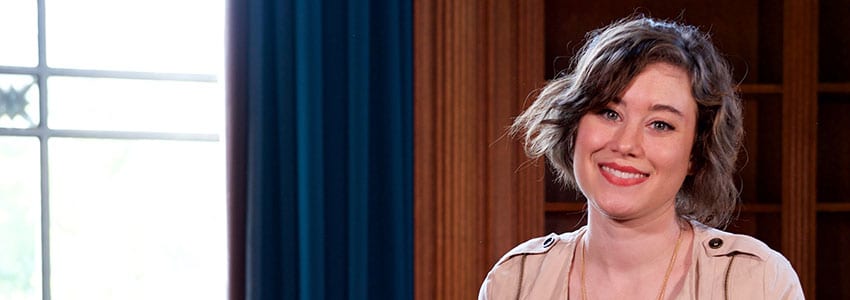Laura is in her thesis year at U-M, undertaking a self-directed project called Playscape at an Ann Arbor elementary school. Building on her dual undergraduate degrees in art education and studio art, she is combining her passions for creative pedagogy in a year-long initiative at the new A2 STEAM school on the north side of Ann Arbor. Last year, Northside Elementary transformed into a K-5 school with specific STEAM—or science, technology, engineering, arts and math—programming. Much of the curriculum is focused on project based learning, where teachers are encouraged to teach through projects and initiatives. That’s where Laura and STEAM art teacher Rachel Van Dyke came in.
“The school was building a new gymnasium and kindergarten wing and needed to move the playground. Instead of simply picking up and moving the existing structure, we wanted to create a child-designed project based on the school’s new design and layout. The kids are the experts in play, and the playground should reflect that.”
They are creating a year-long curriculum for K-5 students at the school that consists of a series of workshops to introduce and incorporate the concepts of play into the classroom curriculum. “Our process is to lead kids through activities and determine a playground proposal based on the concepts the students like most. We will present it to the landscape architects and they will incorporate elements of the proposal into the design.” This is certainly a community project, as the school administration, PTO and local community members are on board. She talks about the helpfulness of the local community, “We had one school parent tell us he’s an engineer and would be happy to help however he can.”
The workshops she is implementing are helping cement classroom curriculum in a creative way. She describes, “The fifth grade was learning about potential and kinetic energy, so we pulled from those concepts and created some activities for the kids to design running pathways over and around a hill. We used their play as educational tool. The fourth graders are learning about group dynamics in the context of community, and we took them outside and discussed playground culture as well, building on that conversation.”
Playground codes are strict and costs are high, so they are pursuing numerous grants to find funds for the proposal the students are developing. Innovation is driving the process to keep costs low as well: “We took some students to the wave field on North Campus, and they loved it. We thought, if we have bulldozers coming in to move the earth, why don’t we incorporate these ideas and design something interesting with the natural landscape.”
This isn’t Laura’s first foray into the classroom. She’s been an active participant in Detroit Connections, serving as a graduate student instructor for undergraduates and has been running her own projects at Detroit Community High School and Bennett Elementary School in Southwest Detroit where she works with classroom based projects and innovative art education.
Last summer, Laura spent part of her summer working with the Ojibwe Charter School in the Upper Peninsula to implement a creative college prep program for local students. “My focus was to use the arts to help youth consider who they are and what their strengths are. I used metaphors through art to think about education and how to reconsider the impacts we may have on community through skills and knowledge gained post high school graduation.”
Engaged scholarship is central to her interests, and Laura is part of the Engaged Pedagogy Fellowship through Rackham. “We are creating a syllabus with engagement components combined. It’s been a wonderful experience to work with students and colleagues from other disciplines, and to share different approaches in reciprocal projects with individuals across the globe,” she explains. She also has been involved with the Residential College program Telling It, an award-winning community-based program designed for vulnerable children and youth grades K-12. “I spent a semester as an intern during my first year and ran my own project there last year. I also was involved with a project called Landscapes of Childhood that used audio narratives to connect folks at Mott Children’s Hospital with Nichols Arboretum.”
As to her goals after graduating this year, she says, “I love the concepts of teaching and am always learning, always curious. I love working with children because they haven’t lost their curiosity yet. I’d like to keep working with youth and want to teach others what I know in terms of engaged pedagogy as well. I’d like to teach in a college setting but foster opportunities for interaction between students and their communities. There is such a reciprocal benefit for communities and children when this happens.”
Laura is reflective of her journey since she came to U-M, saying, “I came to Michigan as a painter. I wanted to bridge the gap between painting and teaching, but found at U-M this interdisciplinary focus that was an interesting challenge. It changed my approach to painting, and truly changed my direction and career path. This is an incredible launching pad and progressive program. My biggest challenge as a grad student is having to process all the amazing things happening and find my own way, determining how to do my own great work with my own voice. The best experience at U-M has been the engagement aspects in and out of Art and Design. There are great mentors and collaborators here.”

